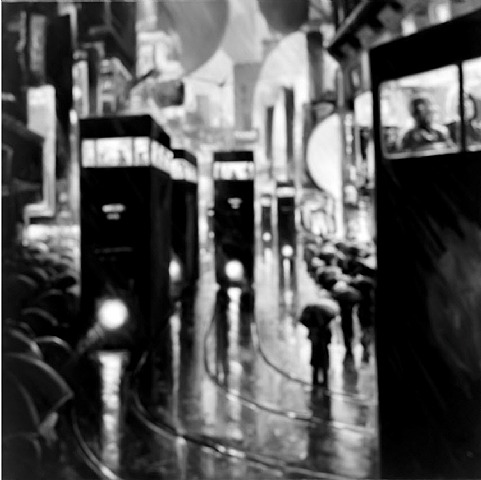
New York’s Soufer Gallery is currently showing an exhibition of work by Adolfo Doring, Andre von Morisse, Sergio Purtell, and Silas Shabelewska. All of these artists use film and silver gelatin printing without digital manipulation in their depictions of urban and industrial landscapes. artnet News spoke with the Norwegian photographer von Morisse about the show.
Bree Hughes: What was the impetus for “The Contemporary Industrial Landscape”?
Andre von Morisse: I felt that there was a strong complimentary dialogue between the different works. They all have a similar composition, abstraction, and mystery in depicting the landscape going from sunny day to dark night, achieving a result that is not about documentation but about personal artistic vision. I wanted to see them together.
BH: Intersections and graceful migrations seem to lead the visitor around the gallery space, reflective of the best of industrial design. How did you decide on scale and placement?
AvM: It was about arranging the different images in context next to each other, and opposite each other to create a flowing dialogue with compliments and opposites. And the difference in size helps the flow.
BH: Could you tell me more about the Contemporary group you belong to, the “art movement in photography”?
AvM: The group does not have a name, but we all make images looking at the man-made world and thinking about our interaction with it. And we all work in classical photography (and classical painting), often in large scale.
BH: Silas Shabelewska’s photographs New England near Millbrook A1a and Route 78, from NJ to PA (c12) are dominated by atmospheric, moody skies, with traffic lights leading the way to and from the city. What inspired you to include these images?
AvM: I think they are very spiritual and subjective. The images selected here where inspired by Mark Rothko’s black paintings he did for the Menil Chapel in Texas. Silas has always been fascinated by the black and grey paintings, which are her Rothko favorites. She wanted to try to “paint in black and greys with light” using the medium of photography to get the feeling of a charcoal drawing. To me they represent the journey between the other images. They pick up where my image End of a new Dawn goes into the night.
Silas Shabelewska, Route 78, from NJ to PA (c12), 2003.
BH: Purtell’s work has almost tragic humor in his juxtaposition of one photograph, Real_634, Brooklyn, NY (2012), which is filled as if it were a crowded puzzle, whereas there is a rhythm and rhyme to the misleading signs in another photograph, titled Real_199, Brooklyn, NY (2012). Do you find humor in these works?
AvM: At first glance of Sergio’s Real_199, Brooklyn, NY, we see an open view of the industrial landscape juxtaposed to a distant view of a city. What is unusual is not just the things seen in the picture, (the “ingester eggs,” the Empire State Building, the old pick-up truck, and the light pole advertising free truck washing), but what we imagine continues outside of the frame. The absence of people is overwhelmed by what has been left behind, resulting in a surreal narrative. To me, it is the daytime version of Adolfo Doring’s blackout photos. They are complete opposites but seem to belong together, and have the same surreal feeling.
In Sergio’s Real_634, Brooklyn, NY, it is hard at first to know what we are looking at. Since it is a photograph, we expect to be able to quickly identify what we are seeing. There is a feeling of an implosion and explosion of shapes. Then we begin to recognize certain elements of the real world—tires, signs, satellite dishes, and we identify the pieces of the puzzle. I felt it complemented my Trams and was a nice contradiction to the stillness in some of the other pictures. And yes, I do find humor in them.
Sergio’s two smaller images deal with human traces left behind—hieroglyphics (graffiti)—that deal with the intrinsic human behavior of subversion and humor and the independence of the individual as an artist.
Sergio Purtell, Real_199, Brooklyn, NY, 2013.
BH: Your photograph Trams (2005) is the only photograph in the show that depicts people, was there a reason?
AvM: I wanted the show to be about the structural spatial landscape; the human and subjective element should be staged by the photographer and filled in by the viewer. In Trams there are figures, but they are subdued and blended into the scene. I felt it related well to the other night scenes.
BH: It seems to me that Adolfo Doring’s photographs are about the chaos and beauty that occurs when technology fails us, such as Blackout 1 and Blackout 3, which depict New York during the 2003 black out. How do you see these images in context to the rest of the show?
AvM: I do not see them as being about the blackout. I see them as unique, poetic images; they seem to me as fantastical as my painted photographs, just the bare city structure asleep, after everyone left, or a few small camp lights silhouetted against the dark mountain range of New York. This show is not about documenting the industrial landscape; it’s about the interpretation, the poetry, and the human interaction with it. It’s about documenting what the artist saw not with their eye but with their mind.
Adolfo Doring, Blackout 3, 2003.